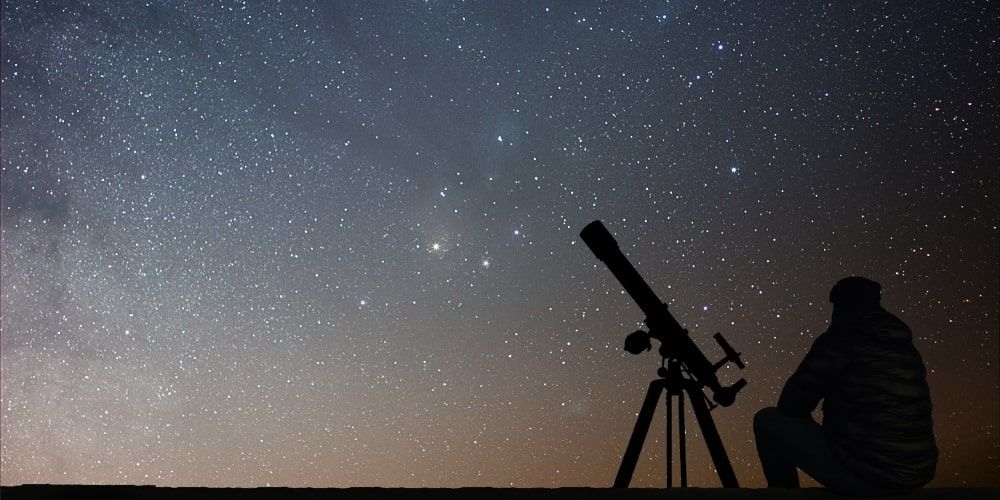With its breathtaking landscapes and postcard-like skies, Italy offers spectacular and inspiring views at any time of the day. Yet, the country is often overlooked once the sun sets. It’s common to spend daylight hours sightseeing and enjoy the night in clubs and restaurants, but astrotourism offers an intriguing alternative: combining travel with the magic of the night sky.
Many spots across Italy, with their clear night skies, provide excellent opportunities for astrotourism. This kind of vacation is growing rapidly, thanks not only to Italy's natural beauty but also to the increasing desire to escape light pollution and crowded urban areas.
In this article, we’ll take you through 5 extraordinary places where artificial lights give way to the magic of the stars, featuring cutting-edge observatories and star-studded skies that will leave you speechless.

What is astrotourism and where to experience it in Italy

Astrotourism is a kind of vacation for romantics and stargazers who want to check out special places at night, looking at the stars and checking out the sky. Astrotourism is a peculiar vacation, perfect for From the Dolomites to the hills of Lazio, there are numerous ideal spots across Italy, each offering a unique experience for stargazing enthusiasts.
Thanks to their geographic location and minimal light pollution, these destinations offer stunningly clear skies and are equipped with dedicated astronomical observation infrastructure.
Italy is home to several observatories and planetariums that organize activities suitable for all levels of expertise. Astrotourism is not just for experts—even beginners and curious newcomers can attend astronomy courses and observe the sky through professional telescopes.
Some regions stand out for their particularly rich offerings: Trentino-Alto Adige, with its pristine alpine landscapes, and Sicily, with its nature reserves and astronomical parks, are just a few examples of territories that have successfully embraced their celestial heritage.
But you don’t have to travel to remote areas to enjoy the spectacle of the stars; even near major cities like Rome and Naples, you’ll find observatories and interesting astronomical sites. These locations offer a romantic escape from urban chaos and a peaceful immersion into the cosmos.
Let’s move on for a journey from North to South to discover the best places where you can enjoy astrotourism in Italy this summer and lose yourself among the constellations.
5. Val d’Ega, Trentino-Alto Adige
4. Monte Porzio Catone, Lazio
3. Madonie Astronomical Park, Sicily
2. Campo Imperatore, Abruzzo
1. Capodimonte Astronomical Observatory, Campania
5. Val d'Ega, Trentino-Alto Adige

Val d'Ega, located in the heart of the Dolomites, is an ideal place for astronomical tourism due to its low light pollution and surrounding natural beauty. Here you will find the Planetarium Alto Adige, where you can participate in observation sessions and interactive workshops. This planetarium, inaugurated in 2013, offers an immersive experience with 3D fulldome projections. Thus you can explore the cosmos with astonishing accuracy.
Val d'Ega also hosts the Max Valier Astronomical Observatory and the Peter Anich Solar Observatory, making this destination unique. The valley's trails, such as the Planet Trail and the Stars Trail, offer perfect panoramic points to admire the starry sky in all its magnificence.
The seasonal events organized by the planetarium, such as the Full Moon Nights, call for enthusiasts from all over Europe. This is why Val d'Ega is a privileged destination for those who wish to explore the cosmos. During these events, you can take part in guided observations and enjoy culinary specialties under a starry sky. This mix of breathtaking nature and advanced astronomical facilities makes Val d'Ega a reference point for astrotourism in Italy.
4. Monte Porzio Catone, Lazio
Monte Porzio Catone is a town located near the Capital and that belongs to the Castelli Romani. It hosts the Astronomical Observatory of Rome, one of the most important structures in Italy for astronomical research and outreach. Founded in 1938 and active since 1965, the observatory is equipped with numerous advanced instruments for sky observation, including the Monteporzio Telescope (MPT) and the LightLAB, an interactive laboratory dedicated to scientific outreach.
The Monte Porzio Catone Observatory offers many activities. There are guided tours and educational programs for people of all ages. One of the main attractions is the AstroLAB, an interactive astronomical laboratory that allows visitors to explore the cosmos in an engaging and instructive way. The observatory regularly organizes public events, such as observational evenings, which offer the opportunity to admire stars, planets, and galaxies through powerful telescopes.
Observation evenings are often accompanied by lectures given by expert astronomers. This allows you to deepen your knowledge of the universe in an evocative and scientifically stimulating environment.
The elevated position and the absence of significant light pollution sources make Monte Porzio Catone an ideal place for astrotourism. It can also be an excellent opportunity to explore Rome or many historical and cultural attractions near there. Sky observation can therefore be part of a 360-degree experience, which includes classic tours and activities that are out of the ordinary.
Discover Rome's nightlife3. Madonie Astronomical Park, Sicily
In the heart of Sicily, the Madonie Astronomical Park offers a unique astrotourism experience. Located in Isnello, Palermo, in the Madonie Park, this observatory is equipped with state-of-the-art telescopes and offers educational programs for all ages. The GAL Hassin International Center for Astronomical Sciences is renowned for its advanced equipment, including the Wide-field Mufara Telescope (WMT) and a planetarium with a 10-meter diameter dome.
Here, thanks to the observation terraces with retractable roofs and numerous telescopes, many popular astronomical events are organized, such as “Shooting Stars” offering visitors breathtaking views of the night sky. Expert astronomers are often there to provide detailed and fascinating explanations. The park also organizes practical activities and educational workshops, making the experience accessible and engaging for both adults and children.
The Madonie Astronomical Park is therefore an unmissable destination for those who want to combine the natural beauty of Sicily with the magic of astronomical observation. Its remote location and absence of light pollution make the Madonie one of the best places in Italy to observe the stars and discover the secrets of the universe.
2. Campo Imperatore, Abruzzo
Located in the Gran Sasso and Monti della Laga National Park, Campo Imperatore is an extraordinary site for astronomical observation. At 2,200 meters above sea level, the Campo Imperatore Observatory offers ideal conditions for stargazing. Founded in 1965, it is the highest professional observatory in Italy, known for research on supernovae and infrared observations using the AZT-24 telescope.
Every year, astronomy enthusiasts gather here for observation events, enjoying breathtaking views of stars and galaxies. The observatory also houses the Schmidt telescope, used for high-precision astronomical surveys. Public observation nights organized by INAF welcome both experts and beginners, offering everyone a chance to explore the cosmos in a unique setting.
The clear atmosphere and intense cold create excellent viewing conditions, making this site perfect for studying the sky.
Campo Imperatore is not only a paradise for astronomy lovers but also a fascinating tourist destination. Nearby, the Vincenzo Rivera Alpine Botanical Garden offers an interesting walk among high-altitude plant species. We also recommend visiting L’Aquila, a city rich in history and culture, just a short drive away, to round out your trip with Renaissance art and architecture.
1. Capodimonte Astronomical Observatory, Campania
The Astronomical Observatory of Capodimonte, located in Naples, is one of the oldest and most prestigious observatories in Italy. Founded in the 19th century, precisely in 1812, it continues to be a center of excellence for astronomical research. The observatory is a section of the National Institute for Astrophysics (INAF) and is located on the Miradois hill, offering a breathtaking panoramic view of the city and the Gulf of Naples.
In addition to being an advanced research center, the Observatory of Capodimonte is also a place where people, especially novices, can get closer to astronomy. It offers guided tours and educational activities that allow visitors to explore the universe through historical and modern telescopes. Among the prominent instruments are the large Repsold meridian circle and the Merz refractor, unique pieces of great historical value.
The panoramic position of the observatory and its adjacent park, which hosts permanent contemporary art exhibitions, make the visit a unique experience. Furthermore, the Museum of Astronomical Instruments (MuSA) inside the observatory allows for a fascinating journey through over two centuries of astronomy history, displaying about a hundred historical objects.
The Observatory of Capodimonte continues to play a fundamental role in promoting scientific culture and education, organizing events such as "Aperitivo sotto le stelle" and educational conferences, attracting enthusiasts and curious people of all ages.
After visiting the observatory, we recommend exploring Naples, a city rich in sights and activities. Also, don't miss the opportunity to visit the Capodimonte Museum, which houses one of the most important art collections in Italy. Located inside the magnificent Royal Palace of Capodimonte, the museum offers works by artists such as Raphael, Caravaggio, and Titian.
Visit the Capodimonte Museum and its treasuresAstrotourism in Italy: exploring cities under the stars
As you’ve seen, astrotourism in Italy allows you to explore destinations through alternative space-time paths, offering a different, original, evocative, and romantic perspective.
Whether you’re a seasoned stargazer familiar with telescopes or simply looking for a meaningful and unusual experience, checking out events at Italy’s observatories can be a way to discover new passions and reconnect with nature, especially during a time of day when we’re usually seated at the dinner table.
So on your next vacation in our cities, why not spend at least one night with your eyes turned to the stars?
About the author
Written on 01/08/2024



Rossella Friggione
Discover five perfect spots for astrotourism in Italy — unique and enchanting destinations to gaze at the stars.